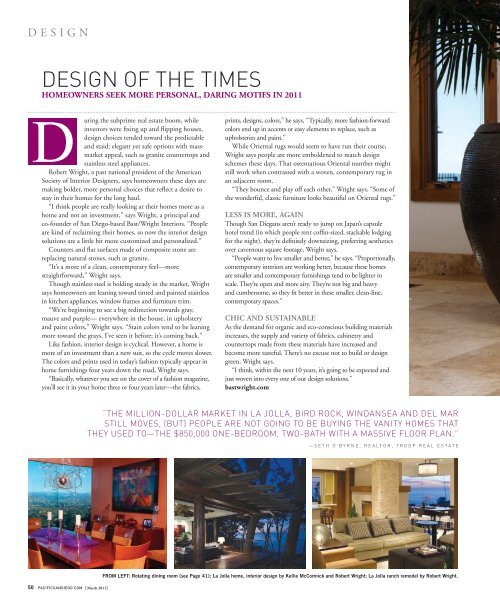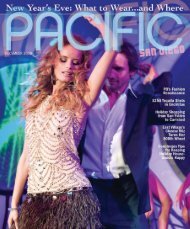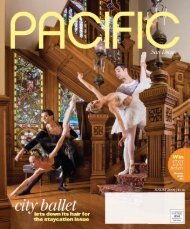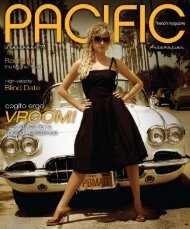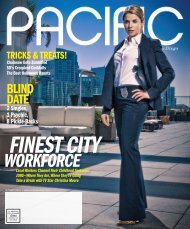PacificSD - Pacific San Diego Magazine
PacificSD - Pacific San Diego Magazine
PacificSD - Pacific San Diego Magazine
Create successful ePaper yourself
Turn your PDF publications into a flip-book with our unique Google optimized e-Paper software.
DESIGN<br />
DESIGN OF THE TIMES<br />
Homeowners seek more personal, daring motifs in 2011<br />
D<br />
uring the subprime real estate boom, while<br />
investors were fixing up and flipping houses,<br />
design choices tended toward the predictable<br />
and staid: elegant yet safe options with massmarket<br />
appeal, such as granite countertops and<br />
stainless steel appliances.<br />
Robert Wright, a past national president of the American<br />
Society of Interior Designers, says homeowners these days are<br />
making bolder, more personal choices that reflect a desire to<br />
stay in their homes for the long haul.<br />
“I think people are really looking at their homes more as a<br />
home and not an investment,” says Wright, a principal and<br />
co-founder of <strong>San</strong> <strong>Diego</strong>-based Bast/Wright Interiors. “People<br />
are kind of reclaiming their homes, so now the interior design<br />
solutions are a little bit more customized and personalized.”<br />
Counters and flat surfaces made of composite stone are<br />
replacing natural stones, such as granite.<br />
“It’s a more of a clean, contemporary feel—more<br />
straightforward,” Wright says.<br />
Though stainless steel is holding steady in the market, Wright<br />
says homeowners are leaning toward tinted and painted stainless<br />
in kitchen appliances, window frames and furniture trim.<br />
“We’re beginning to see a big redirection towards gray,<br />
mauve and purple— everywhere in the house, in upholstery<br />
and paint colors,” Wright says. “Stain colors tend to be leaning<br />
more toward the grays. I’ve seen it before; it’s coming back.”<br />
Like fashion, interior design is cyclical. However, a home is<br />
more of an investment than a new suit, so the cycle moves slower.<br />
The colors and prints used in today’s fashion typically appear in<br />
home furnishings four years down the road, Wright says.<br />
“Basically, whatever you see on the cover of a fashion magazine,<br />
you’ll see it in your home three or four years later—the fabrics,<br />
prints, designs, colors,” he says. “Typically, more fashion-forward<br />
colors end up in accents or easy elements to replace, such as<br />
upholsteries and paint.”<br />
While Oriental rugs would seem to have run their course,<br />
Wright says people are more emboldened to match design<br />
schemes these days. That ostentatious Oriental number might<br />
still work when contrasted with a woven, contemporary rug in<br />
an adjacent room.<br />
“They bounce and play off each other,” Wright says. “Some of<br />
the wonderful, classic furniture looks beautiful on Oriental rugs.”<br />
Less is more, again<br />
Though <strong>San</strong> Diegans aren’t ready to jump on Japan’s capsule<br />
hotel trend (in which people rent coffin-sized, stackable lodging<br />
for the night), they’re definitely downsizing, preferring aesthetics<br />
over cavernous square footage, Wright says.<br />
“People want to live smaller and better,” he says. “Proportionally,<br />
contemporary interiors are working better, because these homes<br />
are smaller and contemporary furnishings tend to be lighter in<br />
scale. They’re open and more airy. They’re not big and heavy<br />
and cumbersome, so they fit better in these smaller, clean-line,<br />
contemporary spaces.”<br />
Chic and Sustainable<br />
As the demand for organic and eco-conscious building materials<br />
increases, the supply and variety of fabrics, cabinetry and<br />
countertops made from these materials have increased and<br />
become more tasteful. There’s no excuse not to build or design<br />
green, Wright says.<br />
“I think, within the next 10 years, it’s going to be expected and<br />
just woven into every one of our design solutions.”<br />
bastwright.com<br />
“The million-dollar market in La Jolla, Bird Rock, Windansea and Del Mar<br />
still moves, (but) people are not going to be buying the vanity homes that<br />
they used to—the $850,000 one-bedroom, two-bath with a massive floor plan.”<br />
—Seth O’Byrne, Realtor, Troop Real Estate<br />
50 pacificsandiego.com { March 2011}<br />
FROM LEFT: Rotating dining room (see Page 41); La Jolla home, interior design by Kellie McCormick and Robert Wright; La Jolla ranch remodel by Robert Wright.


